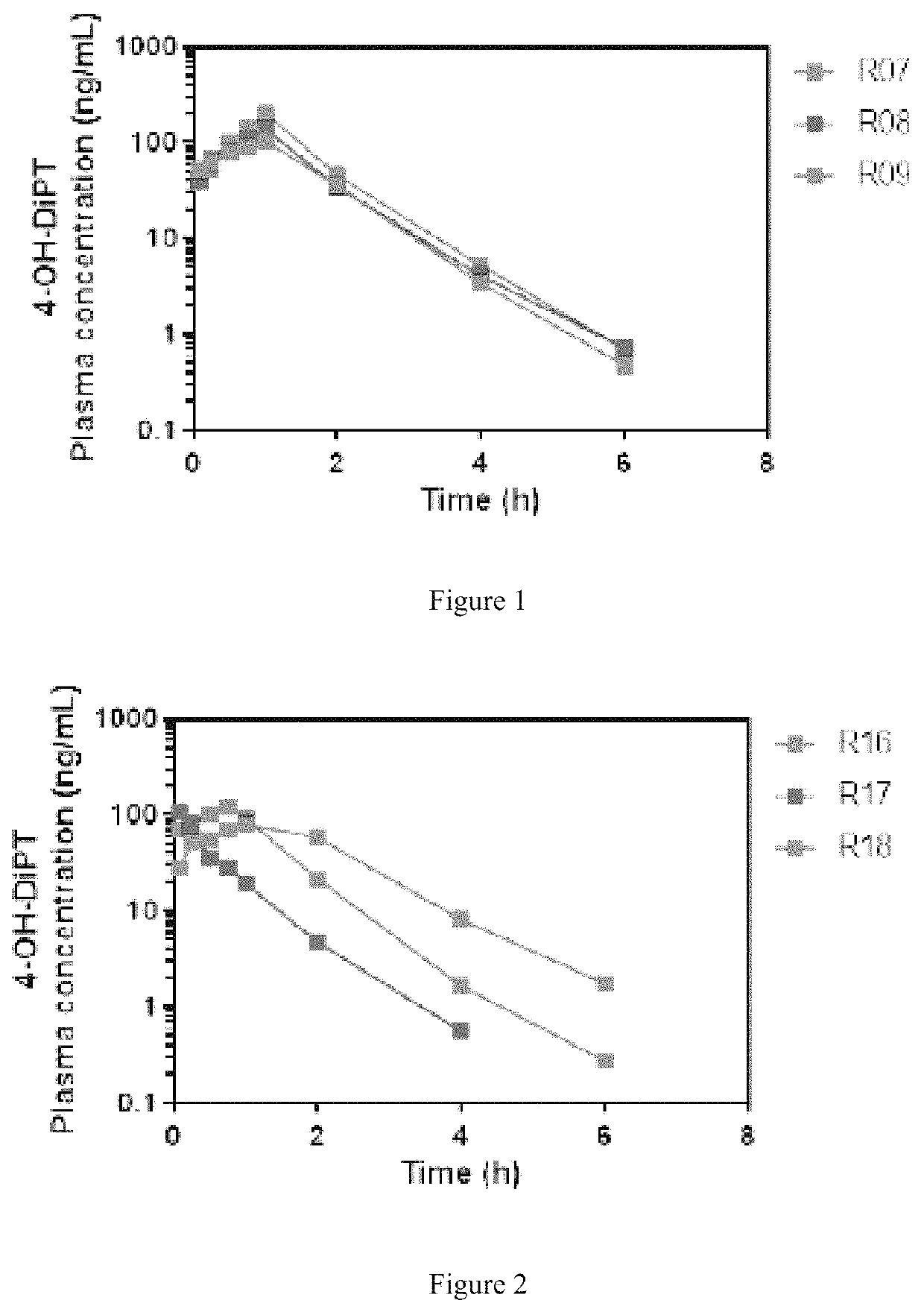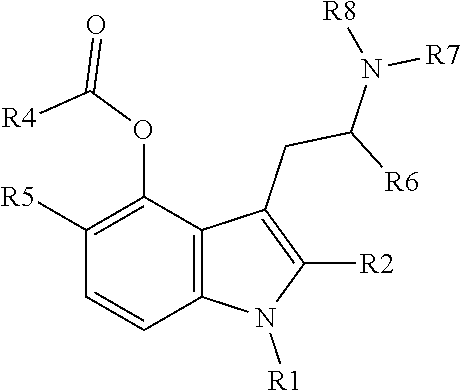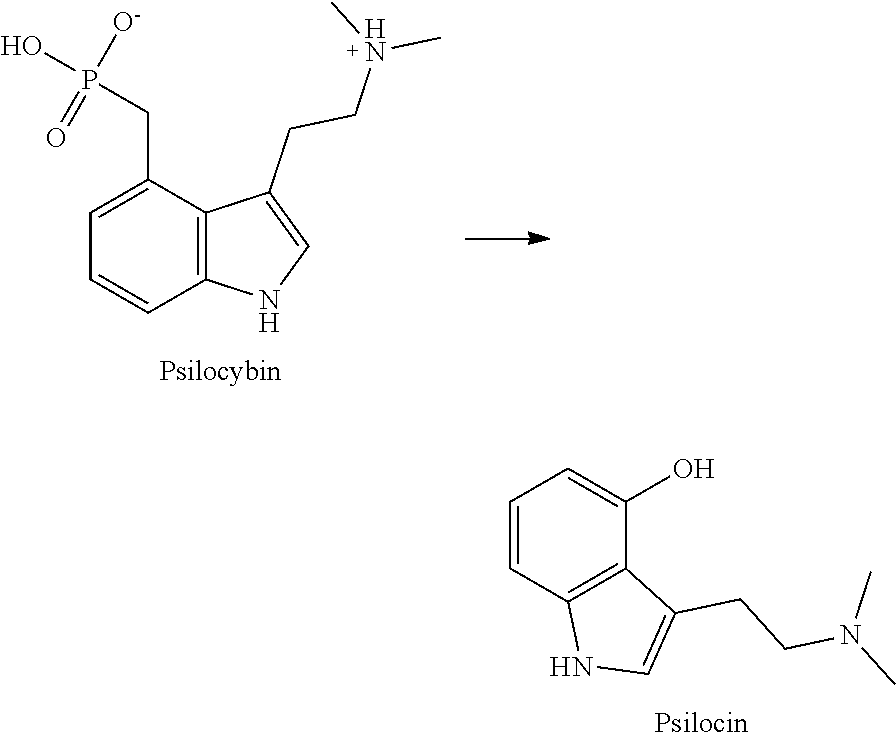Tryptamine prodrugs
a technology of prodrugs and tryptamines, applied in the field of new drugs, can solve the problems of inconsistent cleavage and not predictabl
- Summary
- Abstract
- Description
- Claims
- Application Information
AI Technical Summary
Benefits of technology
Problems solved by technology
Method used
Image
Examples
example 1.4
Example 1. 4-Hemisuccinate of Psilocin
[0128]4-Hydroxyindoles were prepared using methods or modestly adapted from methods described in the literature, such as in Kargbo 2020 ACS Omega): Accordingly, 4-acetoxyindole was reacted with oxalyl chloride in methyl-t-butyl ether (MTBE) and the resulting intermediate was quenched with dimethylamine. The indole-oxalyl-dimethylamide was reduced with Lithium Aluminum Hydride (LAH) in tetrahydrofuran (THF) to give the 4-acetoxy-3-(N,N-dimethylaminoethyl)indole, which was deprotected using aqueous base to give 4-hydroxy-dimethyltryptamine (psilocin).
[0129]The 4-hydroxytryptamine was reacted with an excess of succinic anhydride in dichloromethane (DCM) containing triethylamine, and catalyzed by N,N-dimethylaminopyridine, to give psilocin-4-succinate. A precipitate was formed which was recovered after decantation and trituration with DCM. The solid was acidified in aqueous HCl, purified by chromatography and recovered after evaporation of solvents....
example 2.4
Example 2. 4-hemisuccinate of 4-hydroxy-diisopropyltryptamine (4-OH-DiPT)
[0130]4-Acetoxyindole was reacted with oxalyl chloride in MTBE and the resulting intermediate was quenched with diisopropylamine. The resulting oxalyl-amide was reduced with Lithium Aluminum Hydride (LAH) in THF to give the 4-acetoxy-3-(N,N-diisopropylaminoethyl)indole, which was in turn deprotected with aqueous base to give 4-hydroxy-3-(N,N-diisopropylaminoethyl)indole. In a 250 mL round-bottom flask containing a stir bar was added 4-OH-DiPT (5.8 g, 22.3 mmol, 1 eq.), dissolved in dichloromethane (28 mL, 5×V) and stirred at room temperature. Then succinic anhydride (1.3 eq.) was added slowly to the stirring solution, and the resulting suspension was stirred overnight at room temperature. The precipitate formed in the reaction was recovered by decantation and trituration with DCM. The solid was acidified in aqueous HCl, purified by chromatography and recovered after evaporation of solvents. The structure was co...
example 3.4
Example 3. 4-hemifumarate of 4-OH-DiPT
[0131]4-Benzyloxyindole is reacted with oxalyl chloride in diethylether in the presence of a Friedel-Kraft catalyst and the resulting intermediate is quenched with di-isopropylamine. The resulting oxalyl-amide is reduced with Lithium Aluminum Hydride (LAH) in THF to give the 4-benzyloxy-3-(N,N-diisopropylaminoethyl)indole, which is in turn deprotected using a H2 and Pd / C to give 4-hydroxy-3-(N,N-diisopropylaminoethyl)indole. This substance is reacted with an excess of a diactivated fumaric acid (N-hydroxysuccinimide) in dichloromethane, followed by quenching any unreacted N-hydroxysuccinimide ester with aqueous acid, leaving 4-fumaroyl-3-(N,N-diisopropylaminoethyl)indole.
PUM
| Property | Measurement | Unit |
|---|---|---|
| pKa | aaaaa | aaaaa |
| pKa | aaaaa | aaaaa |
| solubility | aaaaa | aaaaa |
Abstract
Description
Claims
Application Information
 Login to View More
Login to View More - R&D
- Intellectual Property
- Life Sciences
- Materials
- Tech Scout
- Unparalleled Data Quality
- Higher Quality Content
- 60% Fewer Hallucinations
Browse by: Latest US Patents, China's latest patents, Technical Efficacy Thesaurus, Application Domain, Technology Topic, Popular Technical Reports.
© 2025 PatSnap. All rights reserved.Legal|Privacy policy|Modern Slavery Act Transparency Statement|Sitemap|About US| Contact US: help@patsnap.com



